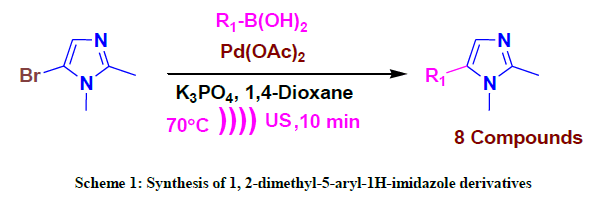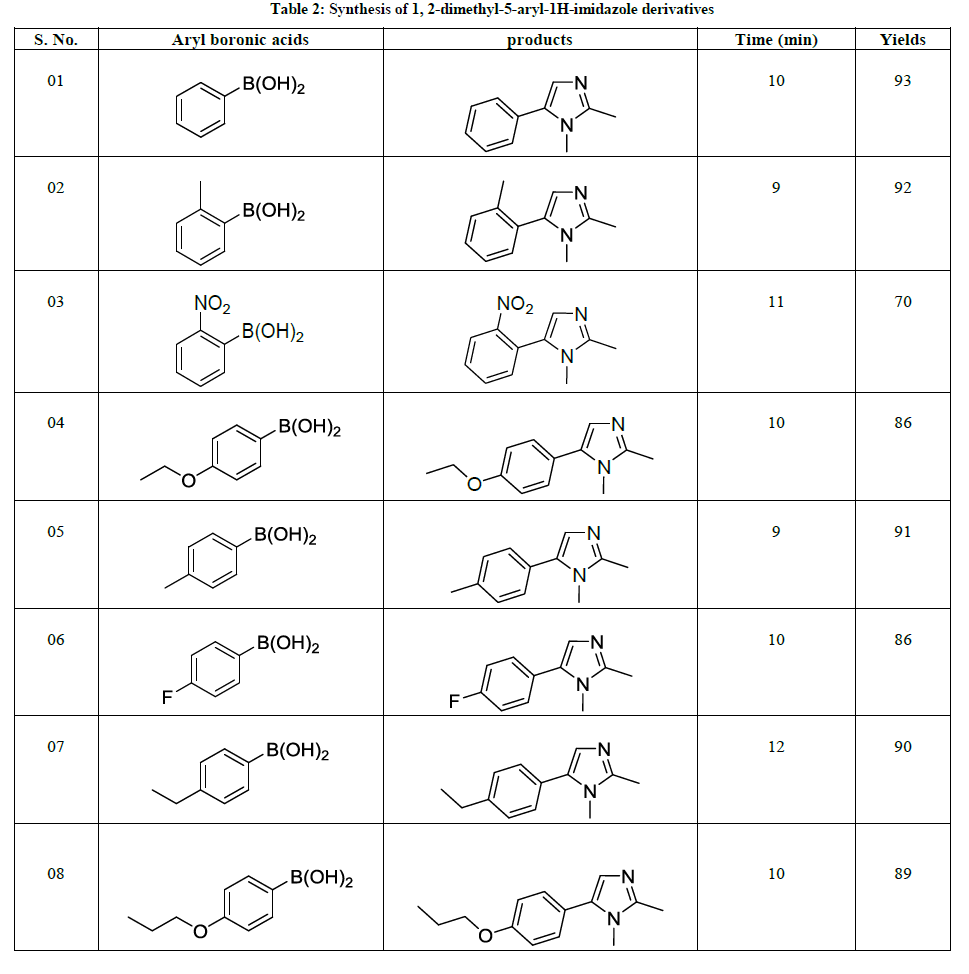Research Article - Der Pharma Chemica ( 2017) Volume 9, Issue 4
Facile Synthesis of 1,2-dimethyl-5-aryl-1H-imidazole Derivatives Under Ultrasonic Irradiation
Madhavi Changa and Krishnendu Biswas*Krishnendu Biswas, Chemistry Division, School of Advanced Sciences, VIT University, Chennai, Tamil Nadu, India, Email: krishnendubiswas@gmal.com
Abstract
Herein we report a novel synthesis method using an efficient Suzuki coupling reaction of 5-bromo-1,2-dimethyl-1H-imidazole and aryl boronic acids, catalyzed by palladium acetate catalyst for the formation of 1,2-dimethyl-5-aryl-1H-imidazole derivatives under ultrasonic irradiation. Using this method, the title compounds were synthesized in a very short time with excellent yields. All the synthesized compounds were characterized by 1H NMR, 13C NMR and mass spectroscopy.
Keywords
5-bromo-1,2-dimethyl-1H-imidazole, Aryl boronic acids, Pd(OAc)2, Suzuki coupling
Introduction
Imidazole and their derivatives are the significant class of heterocyclic compounds which play an important role as flexible building blocks for the synthesis of natural products and as therapeutic agents [1]. Compounds with imidazole moiety have also been found to expand many pharmacological properties and are broadly occupied in biochemical processes [2]. The re-vision of triphenyl imidazole derivatives has been an emergent field within the area of heterocyclic chemistry for the past numerous decades due to their broad range of chemical reactivity and biological activities such as p38 kinase inhibitors I (SB 203580) [3], and cyclooxygenase-2 (Cox-2) inhibitor II [4], antibacterial and antifungal [5]. One of the imidazole derivatives such as 2-substituted imidazolines are synthetically significant due to their use as intermediates in the synthesis of various organic compounds [6,7], catalysts [8], chiral auxiliaries [9] and ligands for asymmetric synthesis [10] chiral catalysts [11] in various synthetic reactions. To date, there are several synthetic methods for 2-imidazolines starting mainly from aldehydes and ethylene diamine with NBS [12]. Some methods include synthesis from nitriles [13], carboxylic acids [14], esters [15], ortho-esters [16], hydroxy-amides and mono or disubstituted chlorodicyanovinyl benzene. It is also called an important synthon for the preparation of biologically active compounds. The synthesis of imidazoles from 1,2-diketone and aldehyde in presence of variety of catalysts by using microwave irradiation have been reported [17-21]. However, these methods suffer from drawbacks, such as poor yields, long duration of synthesis time and limited substrate scoped. Thus, it is desirable to get a general and efficient method for their synthesis. In the present paper, we achieve the goal via Suzuki coupling of 5-bromo-1,2-dimethyl-1H-imidazole with aryl boronic acids catalyzed by Pd (OAc)2 under ultrasound irradiation. The reaction was found to complete in 10 min with good to excellent isolated yields.
Materials and Methods
All the chemicals, solvents, and reagents were AR grade purchased from Sigma-Aldrich, Merck, and SD fine chemicals. FTIR spectra were recorded on Thermofisher Scientific Nicolet Is-10 in the range of 4000-400 cm-1 using KBr pellets. All the reported melting points in the experiment were determined in open capillary tubes on a Mel-Temp apparatus and the NMR spectra were recorded on Bruker Avance-III 400 MHz, the compounds were dissolved in CDCl3 and TMS as internal reference, and finally the mass spectra were recorded on Agilent LC/MSD SL 1100 instrument.
General procedure for 1, 2-dimethyl-5-aryl -1H-imidazole
To a stirred solution of 5-bromo-1, 2-dimethyl-1H-imidazole (1.0 eq) in 1,4-dioxane/water (3 mL, 3:1), potassium phosphate (3.0 eq), Pd (OAc)2 (0.1 eq) and phenyl boronic acid (1.1 eq) were added at room temperature. The resulting reaction mixture kept at 70 C for 10 min, under ultrasonic irradiation. The solvent was concentrated under reduced pressure to obtain the residue. The residue was diluted with water (5 mL) and extracted with ethyl acetate (2 × 5 mL). The combined organic layer was dried over sodium sulfate and evaporated under reduced pressure to get a crude residue. The residue was purified by column chromatography to obtain 1,2-dimethyl-5-phenyl-1H-imidazole as an off-white solid (Scheme 1).

1, 2-dimethyl-5-phenyl-1H-imidazole (1)
Off- white solid; Mp. 102-105ºC; IR, (KBr)/cm–1: 2946.2, 2673.5, 1655.3, 1522.7, 1339.9, 1130.7 and 835.6 H NMR (300 MHz, CDCl3): δ (ppm) =7.55 (d, J=7.1 Hz, 2H), 7.40 (t, J=7.7 Hz, 2H), 7.25 (d, J=7.4 Hz, 1H), 3.45 (s, 3H), 6.8 (s, 1H), 2.4 (s, 3H); 13C NMR (400 MHz, CDCl3): δ (ppm)=145.6, 139.6, 131.7, 128.9, 127.2, 126.4, 125.4, 115.4, 31.7, 13.7; MS(ESI):(m/z=172.18, [M+H].
1, 2-dimethyl-5-(o-tolyl)-1H-imidazole (2)
Off- white solid; Mp. 162-164ºC; IR, (KBr)/cm–1: 3055.7, 2946.0, 2673.9, 1702.1, 1665.0, 1522.7, 1339.9, 1130.7 and 835.6; H NMR (300 MHz, CDCl3): δ (ppm)= 7.3 (t, J=5.0 Hz, 1H), 7.22-7.20 (m, 3H, Ar-H), 6.8 (s, 1H), 3.5 (s, 3H), 3.0 (s, 3 H), 2.25 (s, 3H); 13C NMR (400 MHz, CDCl3): δ (ppm)=143.6, 141.7, 135.4, 130.7, 130.0, 127.0, 126.7, 121.3, 31.2, 21.7, 13.7; MS (ESI):(m/z=186.18, [M+H]).
1, 2-dimethyl-5-(2-nitrophenyl)-1H-imidazole (3)
Yellow solid; Mp. 130-134ºC; IR, (KBr)/cm–1: 3027.6, 2896.0, 2571.9, 1719.1, 1654.6, 1537.4, 1346.9, 1246.7 and 846.6; H NMR (300 MHz, CDCl3): (δ ppm)=8.05 (d, J=8.2 Hz, 1H), 7.90-7.75 (m, 3H, Ar-H), 6.7 (s, 1H), 3.45 (s, 3H), 3.1 (s, 3 H); 13C NMR (400 MHz, CDCl3): δ (ppm)=148.9, 143.6, 141.5, 133.2, 131.2, 128.0, 125.3, 124.7, 24.5, 13.4; MS (ESI):(m/z=217.2, [M+H]).
5-(4-ethoxyphenyl)-1,2-dimethyl-1H-imidazole (4)
Thick liquid; Mp. 124-128ºC; IR, (KBr)/cm–1: 3031.4, 2874.4, 2672.5, 1714.4, 1664.2, 1596.5, 1312.7, 1226.4 and 834.6; 1H NMR (300 MHz, CDCl3): δ (ppm)=7.22 -7.18 (m, 2H), 6.90-6.86 (m, 2H), 6.7 (s, 1H), 4.07 (m, 2H), 3.8 (s, 3H), 3.83 2.59 (s, 3H,), 1.29 (t, J=5.4 Hz, 3H); 13C NMR (400 MHz, CDCl3): δ (ppm)=156.2, 144.3, 141.2, 128.2, 124.9, 121.2, 149.4, 59.3, 28.3, 15.9, 13.4; MS (ESI):(m/z =218.3, [M+H]).
1, 2-dimethyl-5-(p-tolyl)-1H-imidazole (5)
Off-White solid; Mp. 142-146ºC; IR, (KBr)/cm–1: 3027.6, 2814.7, 2559.9, 1724.1, 1632.6, 1525.4, 1336.9, 1256.7 and 836.6; 1H NMR (300 MHz, CDCl3): δ (ppm)=7.62 (d, J=8.2 Hz, 2H), 7.25 (d, J=8.0Hz, 2H), 6.65 (s, 1H), 3.76(s, 3H), 2.54 (s, 3H,), 2.38 (s, 3H); 13C NMR (400 MHz, CDCl3): δ (ppm)=144.4, 141.1, 131.6, 130.8, 129.2, 126.5, 121.4, 27.3, 21.2, 13.6; MS (ESI): (m/z =187.2, [M+H]).
5-(4-fluorophenyl)-1,2-dimethyl-1H-imidazole (6)
Off-White solid; Mp. 154-158ºC; IR, (KBr)/cm–1: 3042.5, 2926.2, 2678.4, 1703.9, 1645.4, 1524.4, 1329.4, 1140.4 and 845.4; 1H NMR (300 MHz, CDCl3): δ (ppm)=7.67 (d, J=8.0Hz, 2H), 7.20 (d, J=8.2 Hz, 2H), 6.64 (s, 1H), 3.73(s, 3H), 2.54 (s, 3H,); 13C NMR (400 MHz, CDCl3): δ (ppm)=161.3, 143.4, 141.4, 131.6, 130.8, 120.2, 119.4, 119.2, 27.1, 13.6; MS (ESI):(m/z =191.09 [M+H]).
5-(4-ethylphenyl)-1,2-dimethyl-1H-imidazole(7)
Thick liquid; Mp. 126-128ºC; IR, (KBr)/cm–1: 3054.4, 2976.8, 2673.5, 1703.5, 1655.7, 1532.9, 1324.7, 1140.2 and 824.8; 1H NMR (300 MHz, CDCl3): δ (ppm)=7.67 (d, J=8.0Hz, 2H), 7.32 (d, J=8.2 Hz, 2H), 6.65 (s, 1H), 3.74 (s, 3H), 2.72 (q, J=4.4 Hz, 2H), 2.54 (s, 3H,), 1.20 (t, J=3.2 Hz, 1H, 3H); 13C NMR (400 MHz, CDCl3): δ (ppm)=145.8, 143.6, 141.3, 130.1, 129.6, 124.8, 124.4, 119.8, 29.2, 26.5, 15.2, 13.7; MS (ESI):(m/z =201.06 [M+H]).
1,2-dimethyl-5-(4-propoxyphenyl)-1H-imidazole (8)
Thick liquid; Mp. 186-188ºC; IR, (KBr)/cm–1: 3065.4, 2926.8, 2634.9, 1712.1, 1658.0, 1524.7, 1369.9, 1128.7 and 832.8; 1H NMR (300 MHz, CDCl3): δ (ppm)=7.36 (d, J=8.0Hz, 2H), 7.09 (d, J=8.2 Hz, 2H), 6.64 (s, 1H), 4.04 (t, J=3.0 Hz, 2H), 3.74 (s, 3H),) 2.54 (s, 3H), 1.28 (m, 2H), 0.96 (q, J=4.2 Hz, 3H); 13C NMR (400 MHz, CDCl3): δ (ppm)=157.4, 143.4, 141.2,130.1, 129.6, 124.6, 120.4, 116.8, 116.6, 70.2, 26.5, 22.9, 15.2, 13.6, 9.2; MS (ESI):(m/z =231.10 [M+H].
Result and Discussion
The coupling reaction between 5-bromo-1,2-dimethyl-1H-imidazole and 4 phenylboronic acid was selected as a model reaction for optimizing the reaction conditions under ultrasound irradiation. First, we explored the effect of temperature on the model reaction (Table 1, entries 1-3). The yields of the product decreased to some extent when the temperature went down. An excellent yield was obtained at 70ºC (Table 1, entry 3). We further optimized bases for the model reaction (Table 1, entries 3, 4 and 5) and found that K3PO4-7H2O is the best base for this reaction system.

Reaction conditions: 5-bromo-1, 2-dimethyl-1H-imidazole (1.0 eq), phenylboronic acid (1.1 eq), base (3.0 eq), catalyst amount (1 mol%), 1,4-dioxane/H2O (3 ml, 3:1), under air. The reactions were monitored by TLC.
Finally the optimized reaction circumstances are as follows, 5-bromo-1,2-dimethyl-1H-imidazole (1.0 eq) and aryl boronic acid (1.1 eq) and potassium phosphate (3.0 eq) in dioxane/water (3 mL, 3:1) under air atmosphere. Pd(OAc)2 were added, and the reaction mixture was heated at 70ºC under ultrasound irradiation for 10 min, and the results are summarized (Table 2, entry’s 1-8). The Suzuki reaction involving 5-bromo-1,2-dimethyl-1H-imidazole, and various aryl boronic acids bearing electron-withdrawing groups, such as nitro and fluoro (Table 2, entries 3 and 6) and electron-donating groups, such as methoxyl, methyl moieties (Table 2, entries 2, 4, 5, 7 and 8), gave high yields. Interestingly, the reaction of phenyl boronic acids provided 93% yield in 10 min (Table 2, entry 1), The coupling between 5-bromo-1,2-dimethyl-1H-imidazole and electron donating group boronic acid smoothly produced the biaryl compound in 88-92% yield after 9 min (Table 2, entry 2, 4, 5, 7 and 8). On the other hand, the electronic effects of the nitrogen atoms of 2-nirophenyl boronic acid affected the reaction. The coupling reaction of 5-bromo-1,2-dimethyl-1H-imidazole with 2-nirophenyl boronic acid gave 70% yield (Table 2, entry 3).

Conclusion
We have developed a general, simple and highly efficient method for the synthesis of 1, 2-dimethyl-5-aryl-1H-imidazole derivatives using Pd(OAc)2 as a catalyst. The formation of desired products proceeded well under ligand-free and aerobic conditions with high excellent yields in a very short period of time using ultrasonic radiations.
Acknowledgements
MC is thankful to Department of Chemistry, Vellore Institute of Technology, Vellore and Chennai campus, Tamil Nadu, India for providing financial assistance and infrastructure facilities for this work.
References
[1] M. Gonzalo, O. Jimene, A. Alberto, H.B. Jesus Busto, Jesus, M. Peregrina, J. Org. Chem., 2011, 76, 4034.
[2] J.G. Lambardino, E.H. Wiseman, J. Med. Chem., 1974, 17, 1188.
[3] M. Jeffrey, McKenna, F. Halley, J.E. Souness, I.M. McLay, D.S. Pickett, A.J. Collis, K. Page, I. Ahmed, J. Med. Chem., 2002, 45, 2173.
[4] I.K. Khanna, Y. Yu, R.M. Huff, R.M. Weier, Y.Y. Zhang, J. Med. Chem., 2000, 43, 3168.
[5] T. Maier, R. Schmierer, K. Bauer, H. Bieringer, H. Buerstell, B. Sachse, Chem. Abstr., 1989, 111, 194.
[6] F. Rondu, G. Le Bihan, X. Wang, A. Lamouri, E. Touboul, G. Dive, T. Bellahsene, B. Pfeiffer, P. Renard, B. Guardiola-Lemaitre, D. Manechez, L. Penicaud, A. Ktorza, J.J. Godfroid, J. Med. Chem., 1997, 40, 3793.
[7] P. Bousquet, Feldman, J. Drugs., 1999, 58, 799.
[8] M. Ueno, K. Imaizumi, T. Sugita, I. Takata, M. Takeshita, Inter. J. Immunopharmacol., 1995, 17, 597.
[9] T. Hayashi, E. Kishi, V.A. Soloshonok, Y. Uozumi, Tetrahedron. Lett., 1996, 37, 4969.
[10] Madhavi changa, Krishnendu Biswas, Der. Pharma. Chemica., 2016, 18, 324.
[11] H. Fujioka, K. Murai, Y. Ohba, A. Hiramastu, Y. Kita, Tetrahedron. Lett., 2005, 46, 2197.
[12] E.E. Korshin, L.I. Sabirova, A.G. Akhadullin, Y.A. Levin, Russian. Chem. Bull., 1994, 43, 431.
[13] H. Vorbriiggen, K. Krolikiewicz, Tetrahedron. Lett., 1981, 22, 4471.
[15] G. Neef, U. Eder, G.J. Sauer, Org. Chem., 1981, 46, 2824.
[16] A.J. Hill, J.V. Johnston, J. Am. Chem. Soc., 1954, 76, 922.
[17] N.A. Boland, M. Casey, S.J. Hynes, J.W. Matthews, M.P. Smyth, J. Org. Chem., 2002, 67, 3919.
[18] S. Balalai, M.M. Hashemi, M.A. Akhbari, Tetrahedron. lett., 2003, 44, 1709.
[19] C.F. Raymond, R.J. Tetrahedron. Lett., 1990, 31, 1771.
[20] A.Y. Usyatinsky, Y.L. Khemelnisky, Tetrahedron. Lett., 2000, 41, 5034.
[21] M.M. Heravi, K. Bakhtiari, Oskooie, J. Med. Catal, A. Chem., 2007, 263, 279.



